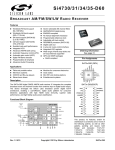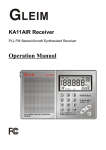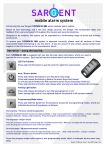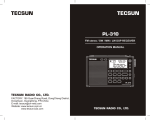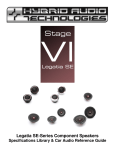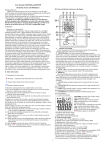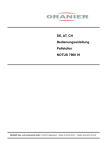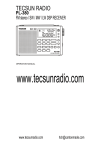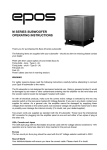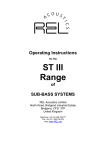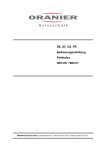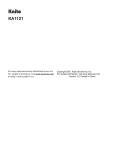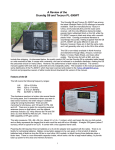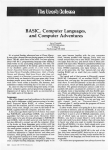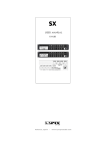Download Grundig G8 Traveler I
Transcript
MT Grundig G8 Traveler II Digital AM/FM/SW Pocket Receiver REVIEW Solid Performance and Features for Just $50 By Gary Sargent, KE8WO E ton has a history of bringing various types of radios to market throughout the year. They offer radios under the Eton or the Grundig labels. A new model in the low cost AM / FM / SW pocket sized portable is the Grundig G8 Traveler II. The G8 has an interesting set of features that have attracted much interest. I decided I “needed” a G8 and obtained one recently. My hands-on evaluation and comparison to other lower cost radios follows. The following are the main G8 features and specifications provided by the manufacturer: • Receives FM/MW/SW (3150 through 21950 kHz )/LW (AM and FM frequency range user selectable depending on continent) • Utilizes SI4734 DSP Radio Microchip • Four tuning modes: ○ a) jog dial manual tuning ○ b) auto scan tuning ○ c) memory pre-set auto scan tuning ○ d) memory pre-set manual scan tuning • Multiple tuning step sizes and variable rate tuning • Auto Tuning Storage (ATS) function: AM, FM and LW (not SW) • 500 memories (100 each: AM, LW and FM, 200 on SW) • Digital tuning with digital frequency readout (LCD) with backlight • Multi-functions digital display for frequency, signal strength, S/N ratio, clock and alarm, temperature and battery status. • Independent local and world times • Sleep timer and alarm clock (either radio or buzzer) with snooze option • 3.5 mm headphone output jack Powered by 3-AA batteries • DC jack - 6V center negative ❖ Inside the Box The G8 is 5.3 by 3.4 by 1.1 inches, and weighs under one half pound. It is shirt pocket sized for larger pockets. It has the flat black rubbery finish common to several other models of Eton radios. The radio is solidly constructed and has an overall attractive appearance and feel. The 21 inch telescoping antenna tilts and swivels. A thin pop-out prop from the back angles the G8 for table top use. Packed in the box were the following items: G8 Radio Stereo ‘ear-bud’ style headphones Nice carry pouch and carry strap User’s manual and warranty card 68 MONITORING TIMES January 2010 ❖ G8 Operational Controls The left side of the G8 has just a standard stereo headphone jack and a common DC power in jack. The right side of the unit has a rotary tuning/multi-purpose control and a rotary volume control. Both of these controls are of the detent type, meaning you get a small bump as you rotate these controls. The tuning control is also used to select the desired memory channel and to set the current time or the alarm time. When tuning AM or SW, there is very short “chuffing.” It’s not overly objectionable, but nonetheless it is not continuous, stepless tuning. The detented volume control is such that at times you wish for finer control of the volume. The front of the G8 is dominated by the large display and a door hiding additional controls. There are five buttons along the top left edge primarily for band selection. These small buttons take a little force to activate. On the G8’s top right are three buttons for power and to control the display and tuning modes. Many of the buttons have dual functions via a short or long press of the button. Not seen on the front panel is an under-two-inch speaker which works well and has typical sound for a small radio. The LCD display is large with an amazing amount of informational options that the user can control. The display is illuminated with any control operation for about 2 seconds. The backlight may be locked on. With the radio off, the current time is displayed along with a user selected world time, alarm time, or current temperature. When the radio is on, the user can also opt to choose to display an innovative signal strength/quality pair of numbers (see the photo). When in the memory or preset mode, the memory number is also displayed. Other icons are used to indicate band currently receiving, tuning rate selected, sleep time status and battery strength. As you can see, this is one busy display. Behind the fold-down door is a 24-position rotary switch used to set your time zone and control the world time when displayed. Also “behind the door” are four buttons to control the radio memories and to set current time and alarm times. Lastly is a pin-hole access to a reset button. The two memory buttons allow to store a frequency in memory or to delete one or all memories. Typically, you will only need to have the door open to save or delete a memory preset. The top left buttons select the band to be received. Two buttons select either the next higher or lower SW meter band from 90 meters to 13 meters. The current meter band is displayed briefly while tuning. These buttons also are used to select the FM (e.g. 87.5 to 108 MHz) and AM (i.e., 9 or 10 kHz channels) band plans. The “AM/LW” alternates between the AM and LW bands. This button can also be used to omit the LW band. Lastly, the “AM/LW” and “FM” buttons are used to select the Auto Tuning Storage (ATS) function. ATS is not available for SW reception. The user can choose from a set of sleep times, including no sleep time, when powering up the G8. The “Display” button allows the user to select what information is displayed when the radio in off and when it is on. The “VF/VM” button controls several of the G8’s powerful features. This button normally selects from VFO or preset/memory operation. In VFO mode, the rotary control is used to dial the frequency. In memory mode, the rotary control sequentially selects from the band’s memory channels. This button controls the tuning step size when given a long press. The G8 features variable rate tuning where it selects a slow or fast step size, depending on how quickly you spin the tuning dial. The net result is that the user has good control of tuning rates to allow zipping through the bands at a maximum step size of 100 kHz for AM and SW, or 1 MHz for FM. This goes a long way towards compensating for the lack of a keypad to enter frequencies directly. On the other hand, most of this is not documented in the skimpy user manual. ❖ DSP under the Hood Grundig does not advertise the fact that the G8 is based the Silicon Labs SI743x DSP (Digital Signal Processing) based radio integrated circuit. See the May 2009 issue of MT for the review of the DE1123 receiver for the benefits of this design approach. For the G8, this means solid performance and support for the features described above. One interesting feature the DSP chip provides is a display of signal quality as two double-digit numbers. The first is received signal strength (RSSI) in dBuv which ranges from 0 to 80 or more. Bigger is better. The second number is a signal to noise ratio (SNR) which also ranges from 0 to 25 or more. It is unusual for this level of signal quality to be available even on a radio several times the G8’s $50 price point. Some G8 owners will not care about this and may even be confused with these numbers displayed. ❖ Radio Performance I decided to compare the G8’s performance to my Degen/Kaito 1103 receiver. The 1103 is in wide use and is a top-notch performer in the $75 to $100 price range of portable receivers. My expectation was for the G8 to fall short of the 1103’s performance. The G8 offers very good performance in the AM MW range with sensitivity only slightly reduced compared to the 1103. The G8 selectivity is excellent and has slightly less adjacent channel spill over when the 1103 is set to the wide filter setting. The G8 had low level heterodynes on a few weak stations, while the 1103 did not. The DSP chip supports multiple filter bandwidths, but there is no control to select bandwidth, and the G8’s specifications do not detail this nor any other technical details (reported 3 kHz per other sources). The G8’s longwave performance is poor, at least to the extent I have stations to tune in. I did manage to tune in a few local aero beacons, but the 1103 was able to receive many more. FM performance on the G8 was noticeably superior to the 1103 in both sensitivity and selectivity. Remote stations only 200 kHz from a powerful local station could be received. Powerful locals did not swamp large sections of the band as has been the case on some lesser performing receivers I have used. Stereo audio in headphones was free of noise and had high quality sound at all volume settings. The G8 does not have any form of base or treble controls to tailor audio. Overall, the G8’s FM performance is the best of the several portable radios I own, including besting the Eton E1. I found FM stations I did not even know were receivable at my location. SW coverage is continuous from 3150 through 21950 kHz, which includes the 90 to 13 meter bands. The G8’s sensitivity is a minor step behind the 1103, using their whip antennas. As with the AM BCB, the G8 does have good immunity from splatter from another station just 5 kHz away. There is no connector for an external antenna nor a signal attenuator button. Just as I found with the DSP-based DE1123 radio, there is a SW performance caveat: I live in a typical suburban area (Dayton, Ohio) with a 5 kW AM station about five miles away that has interfered to some extent on all of my radios (including a Sony 2010 and an Eton E1). This station shows up on most of the SW bands on the G8 as a clear or garbled subdued background on many channels. This is not too much of a problem for medium to strong SW stations. Shortening the whip or just touching the whip with your finger will usually reduce or eliminate this interference. Users without strong local AM stations will likely not experience this. To illustrate the usefulness of the dBuv signal strength readout, this strong local AM station peaks at a value of 82. This value converts to about 12.5 millivolts of signal measured by the G8. Typical SW stations will measure in the 20 to 40 dBuv range, some lower, some much higher. This converts to around 32 microvolts. So the local AM interfering station is some 400 times stronger. I consider the G8 only adequate for SW reception, due to the local interference issue. If this AM interference were not present, the G8’s SW performance could be very good and just a step behind the DE1103. But beware if you live in a medium to large metro area with strong local AM stations and wish to use the G8 primarily for SW reception. The G8 Pluses • Pocket sized • Exceptional feature set • Exceptional FM reception • Very good AM reception • Acceptable SW reception The G8 Negatives • SW interference from strong local AM MW stations • Lack of sensitivity on the LW band ❖ Bottom Line For a $50 radio, the G8 offers an excellent value with very acceptable overall radio performance, along with loads of features. It is available from several suppliers with a street price of $50 or less. (The G8 is available from Grove Enterprises: see ad on page 73.) MT X The Real Deal PRESS If you order NOW, you will get 14 ISSUES for the price of 12! That’s right, for only $19.95 you’ll get an EXTRA 2 MONTHS! Just mention code MTJAN10 when you place your order. And this great offer INCLUDES our all-new MTXTRA foreignlanguage shortwave guide! Don’t miss this fantastic offer, place your order TODAY! MT X PRESS www.grove-ent.com January 2010 MONITORING TIMES 69


